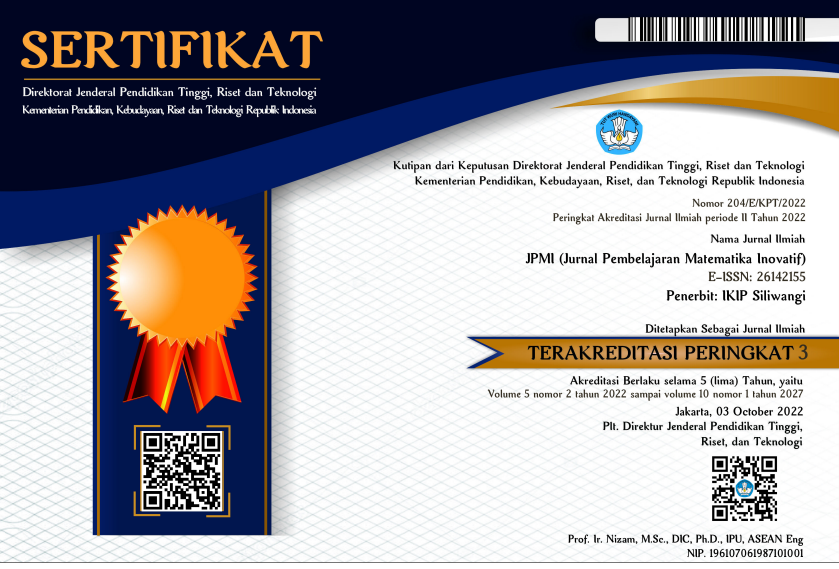PROFIL KEMAMPUAN LITERASI MATEMATIKA DITINJAU DARI GAYA BELAJAR
DOI:
https://doi.org/10.22460/jpmi.v5i6.12865Kata Kunci:
Learning Style, Mathematical Literacy AbilityAbstrak
Learning style is a method used by each individual to absorb information easily and quickly. Learning style is one of the supporting factors related to mathematical literacy ability. This can happen because learning styles can affect learning outcomes and student achievement. In this study, the learning style used is the VAK learning style (Visual, Audiotori, Kinesthetic). The purpose of this research is to describe how students' mathematical literacy skills at VAK learning style. Selected 1 student who has the highest score on the visual learning style, 1 student who has the highest score on the auditory learning style, and 1 student who has the highest score on the kinesthetic learning style. The results obtained from this study are students with the highest visual learning style can complete level 1 correctly. at level 3 and 4 students with the highest visual learning style came to the indicators of translating problems. Meanwhile, students with the highest auditory learning style were only able to complete level 3 correctly. Meanwhile, students with the highest kinesthetic learning style can complete level 1 correctly. At level 3 only errors occur when drawing conclusions. So it can be concluded that students with the highest visual learning styles can achieve higher competencies than students with auditory and kinesthetic learning styles.
Referensi
Amelia, Kiki Nia Sania Effendi, K. E. L. (2021). Analisis Kemampuan Literasi Matematis Siswa Kelas X SMA dalam Menyelesaikan Soal PISA. Matematika Dan Pendidikan Matematika, 4(2), 136–145.
Breen, S., Cleary, J., & Shea, A. O. (2009). An Investigasion Of The Mathematical Literacy Of First Year Third Level Students In The Republic Of Ireland. International Journal of Mathematical Education in Science and Technology, 2, 40.
DePorter, B. & H. M. (2002). Quantum Teaching. Membiasakan Belajar Nyaman dan Menyenangkan. Kaifa.
Edimuslim, E., Edriati, S., & Mardiyah, A. (2019). Analisis Kemampuan Literasi Matematika ditinjau dari Gaya Belajar Siswa SMA. Suska Journal of Mathematics Education, 5(2), 95. https://doi.org/10.24014/sjme.v5i2.8055
Edo, S. I., Hartono, Y., & Putri, R. I. I. (2013). Investigating secondary school students’ difficulties in modeling problems PISA-model level 5 and 6. Journal on Mathematics Education, 4(1), 41–58. https://doi.org/10.22342/jme.4.1.561.41-58
Fitriyani, D., & Nurhikmayati, I. (2020). Analisis Kesalahan Literasi Matematis Siswa Berdasarkan Prosedur Newman. Prosiding Seminar Nasional …, 61–72. http://prosiding.unma.ac.id/index.php/semnasfkip/article/view/302
Genc, M., & Erbas, A. K. (2019). Secondary mathematics teachers’ conceptions of mathematical literacy. International Journal of Education in Mathematics, Science and Technology, 7(3), 222–237.
Hera, R., & Sari, N. (2015). Literasi Matematika: Apa, Mengapa dan Bagaimana?. Seminar Nasional Matematika Dan Pendidikan Matematika UNY, 713–720.
Kemendikbud, B. (2019). Pendidikan di Indonesia belajar dari hasil PISA 2018. Pusat Penilaian Pendidikan Balitbang KEMENDIKBUD, 021, 1–206. http://repositori.kemdikbud.go.id/id/eprint/16742
Khoirudin, A., Dwi Styawati, R., & Nursyahida, F. (2017). Profil Kemampuan Literasi Matematika Siswa Berkemampuan Matematis Rendah Dalam Menyelesaikan Soal Berbentuk Pisa. Aksioma, 8(2), 33. https://doi.org/10.26877/aks.v8i2.1839
Mandelson, A. L. (2004). For Whom is a picture Worth a Thousand Words? Effects of the Visualizing Cognitive Style and Attention on Processing of News Photos. 04(1), 85–105.
Marpaung, J. (2016). Pengaruh Gaya Belajar Terhadap Prestasi Belajar Siswa. KOPASTA: Jurnal Program Studi Bimbingan Konseling, 2(2), 13–17. https://doi.org/10.33373/kop.v2i2.302
Muti’ah, R., Irmayanti, Saragih, S. Z., Rohana, Ritonga, M. Thovawira, F. A., Ritonga, K. (2019). Literasi Matematika Upaya Meningkatkan Kemampuan Literasi Matematika Siswa melalui Kegiatan Pembelajaran. deepublish.
Nariyati, R. Y. (2010). Literasi matematis siswa pada konten change and relationship ditinjau dari gaya belajar siswa. Jurnal Pendidikan Dan Pembelajaran Khatulistiwa, 1–9. https://jurnal.untan.ac.id/index.php/jpdpb/article/view/21969
OECD. (2019). PISA 2018 Assesment and Analitycal framework. OECD Report. http://doi.org/10.1787/b25efab8-en
Reksadini, M. U. (2019). Analisis Kemampuan Koneksi Matematis Pada Model Pembelajaran Conincon (Contructivistik Integratif Contextual) Ditinjau Dari Gaya Belajar Peserta Didik Pada Materi Barisan Kelas IX Di MAN 1 Kota Semarang. Semarang : Universitas Islam Negeri Walisongo.

















